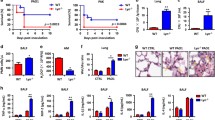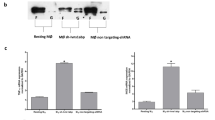Abstract
Supervillin (SVIL) is an actin-binding and membrane-associated protein, which belongs to villin/gelsolin family. It has been reported that SVIL was involved in the regulation of macrophages’ movement and lipopolysaccharide (LPS) increased the SVIL mRNA expression in neutrophils, but the underlying mechanisms remain unknown. This work investigated the underlying molecular mechanisms of LPS regulating SVIL expression in macrophages and hence the possible role of SVIL in LPS-induced inflammation. We found that in THP-1-derived macrophages, LPS obviously increased SVIL mRNA and protein expression. Inhibition of TLR4 by Resatorvid (Res) remarkably reversed the LPS-induced SVIL expression. Additionally, inhibition of ERK1/2 signaling pathway (by U0126 or GDC-0994) and NF-κB (by BAY) significantly reduced the LPS-induced SVIL expression. Interestingly, down-regulation of SVIL by SVIL-specific shRNAs significantly attenuated the expression of IL-6, IL-1β & TNF-α induced by LPS at both mRNA and protein levels. Furthermore, we also observed that SVIL knockdown decreased the proportion of cells in G2/M phase and increased the proportion of cells in S & G0-1 phase of THP-1 derived macrophages, but did not influence the cell viability. Taken together, we demonstrated that LPS induced the expression of SVIL via activating TLR4/NF-κB and ERK1/2 MAPK pathways, and SVIL participated in the inflammatory response of LPS-induced IL-6, IL-1β and TNF-α upregulation in macrophages.









Similar content being viewed by others
AVAILABILITY OF DATA AND MATERIALS
The materials and analyzed data sets generated during the current study are available from the corresponding author on reasonable request.
REFERENCES
Nasser, M.I., S. Zhu, H. Huang, M. Zhao, B. Wang, H. Ping, Q. Geng, P. Zhu. 2020. Macrophages: First guards in the prevention of cardiovascular diseases. Life Sciences 250: 117559.
Fiordelisi, A., G. Iaccarino, C. Morisco, E. Coscioni, and D. Sorriento. 2019. NFkappaB is a Key Player in the Crosstalk between Inflammation and Cardiovascular Diseases. International Journal of Molecular Sciences 20 (7): 1599.
Honold, L., and M. Nahrendorf. 2018. Resident and Monocyte-Derived Macrophages in Cardiovascular Disease. Circulation Research 122 (1): 113–127.
Bäck, M., A. Yurdagul, I. Tabas, K. Öörni, and P.T. Kovanen. 2019. Inflammation and its resolution in atherosclerosis: Mediators and therapeutic opportunities. Nature Reviews Cardiology 16 (7): 389–406.
Barrett, T.J. 2020. Macrophages in Atherosclerosis Regression. Arteriosclerosis, Thrombosis, and Vascular Biology 40: 20–33.
Kavurma, M.M., K.J. Rayner, and D. Karunakaran. 2017. The walking dead: Macrophage inflammation and death in atherosclerosis. Current Opinion in Lipidology 28 (2): 91–98.
Shapouri-Moghaddam, A., S. Mohammadian, H. Vazini, M. Taghadosi, S.A. Esmaeili, F. Mardani, B. Seifi, A. Mohammadi, J.T. Afshari, and A. Sahebkar. 2018. Macrophage plasticity, polarization, and function in health and disease. Journal of Cellular Physiology 233 (9): 6425–6440.
Pestonjamasp, K.N., R.K. Pope, J.D. Wulfkuhle, and E.J. Luna. 1997. Supervillin (p205): A novel membrane-associated, F-actin-binding protein in the villin/gelsolin superfamily. Journal of Cell Biology 139: 1255–1269.
Crowley, J.L., T.C. Smith, Z. Fang, N. Takizawa, and E.J. Luna. 2009. Supervillin reorganizes the actin cytoskeleton and increases invadopodial efficiency. Molecular Biology of the Cell 20: 948–962.
Fang, Z., and E.J. Luna. 2013. Supervillin-mediated suppression of p53 protein enhances cell survival. Journal of Biological Chemistry 288: 7918–7929.
Spinazzola, J.M., T.C. Smith, M. Liu, E.J. Luna, and E.R. Barton. 2015. Gamma-sarcoglycan is required for the response of archvillin to mechanical stimulation in skeletal muscle. Human Molecular Genetics 24 (9): 2470–2481.
Ting, H.J., S. Yeh, K. Nishimura, and C. Chang. 2002. Supervillin associates with androgen receptor and modulates its transcriptional activity. Proceedings of the National academy of Sciences of the United States of America 99 (2): 661–666.
Oh, S.W., R.K. Pope, K.P. Smith, J.L. Crowley, T. Nebl, J.B. Lawrence, et al. 2003. Archvillin, a muscle-specific isoform of supervillin, is an early expressed component of the costameric membrane skeleton. Journal of Cell Science 116: 2261–2275.
Bhuwania, R., S. Cornfine, Z. Fang, M. Kruger, E.J. Luna, and S. Linder. 2012. Supervillin couples myosin-dependent contractility to podosomes and enables their turnover. Journal of Cell Science 125: 2300–2314.
Cervero, P., C. Wiesner, A. Bouissou, R. Poincloux, and S. Linder. 2018. Lymphocyte-specific protein 1 regulates mechanosensory oscillation of podosomes and actin isoform-based actomyosin symmetry breaking. Nature Communications 9 (1): 515.
Morozumi, T., T. Kubota, N. Sugita, Y. Ohsawa, K. Yamazaki, and H. Yoshie. 2001. Elevated mRNA expression for supervillin and vascular endothelial growth factor in human neutrophils stimulated with lipopolysaccharide from Porphyromonas gingivalis. Journal of Periodontal Research 36 (3): 160–168.
Peri, F., and M. Piazza. 2012. Therapeutic targeting of innate immunity with Toll-like receptor 4 (TLR4) antagonists. Biotechnology Advances 30 (1): 251–260.
Di-Lorenzo, F., C. De-Castro, A. Silipo, and A. Molinaro. 2019. Lipopolysaccharide structures of Gram-negative populations in the gut microbiota and effects on host interactions. FEMS Microbiology Reviews 43 (3): 257–272.
Dhande, I., W. Ma, and T. Hussain. 2015. Angiotensin AT2 receptor stimulation is anti-inflammatory in lipopolysaccharide-activated THP-1 macrophages via increased interleukin-10 production. Hypertension Research 38 (1): 21–29.
Liu, D., G. Cao, L. Han, Y. Ye, Y. SiMa, and W. Ge. 2016. Flavonoids from Radix Tetrastigmae inhibit TLR4/MD-2 mediated JNK and NF-κB pathway with anti-inflammatory properties. Cytokine 84: 29–36.
Bode, J.G., C. Ehlting, and D. Häussinger. 2012. The macrophage response towards LPS and its control through the p38(MAPK)-STAT3 axis. Cellular Signalling 24 (6): 1185–1194.
Guha, M., and N. Mackman. 2001. LPS induction of gene expression in human monocytes. Cellular Signalling 13 (2): 85–94.
Mandrekar, P., and G. Szabo. 2009. Signalling pathways in alcohol-induced liver inflammation. Journal of Hepatology 50 (6): 1258–1266.
Gangopadhyay, S.S., E. Kengni, S. Appel, C. Gallant, H.R. Kim, P. Leavis, et al. 2009. Smooth muscle archvillin is an ERK scaffolding protein. Journal of Biological Chemistry 284 (26): 17607–17615.
Li, Y., M. Reznichenko, R.M. Tribe, P.E. Hess, M. Taggart, H. Kim, J.P. DeGnore, S. Gangopadhyay, K.G. Morgan. 2009. Stretch activates human myometrium via ERK, caldesmon and focal adhesion signaling. PLoS ONE 4(10): e7489.
Fang, Z., N. Takizawa, K.A. Wilson, T.C. Smith, A. Delprato, M.W. Davidson, et al. 2010. The membrane-associated protein, supervillin, accelerates F-actin-dependent rapid integrin recycling and cell motility. Traffic 11 (6): 782–799.
Liu, H.P., M.C. Yu, M.H. Jiang, J.X. Chen, D.P. Yan, F. Liu, and B.X. Ge. 2011. Association of supervillin with KIR2DL1 regulates the inhibitory signaling of natural killer cells. Cellular Signalling 23 (2): 487–496.
Chen, X., S. Zhang, Z. Wang, F. Wang, X. Cao, Q. Wu, C. Zhao, H. Ma, F. Ye, H. Wang, and Z. Fang. 2018. Supervillin promotes epithelial-mesenchymal transition and metastasis of hepatocellular carcinoma in hypoxia via activation of the RhoA/ROCK-ERK/p38 pathway. Journal of Experimental & Clinical Cancer Research 37 (1): 128.
Poltorak, A., X. He, I. Smirnova, M.Y. Liu, C. Van-Huffel, X. Du, D. Birdwell, E. Alejos, M. Silva, C. Galanos, M. Freudenburg, P. Ricciardi-Castagnoli, B. Layton, and B. Beutler. 1998. Defective LPS signaling in C3H/HeJ and C57BL/10ScCr mice: Mutations in Tlr4 gene. Science 282 (5396): 2085–2088.
Beutler, B., X. Du, and A. Poltorak. 2001. Identification of Toll-like receptor 4 (Tlr4) as the sole conduit for LPS signal transduction: Genetic and evolutionary studies. Journal of Endotoxin Research 7 (4): 277–280.
Shang, L., T. Wang, D. Tong, W. Kang, Q. Liang, S. Ge. 2018. Prolyl hydroxylases positively regulated LPS-induced inflammation in human gingival fibroblasts via TLR4/MyD88-mediated AKT/NF-κB and MAPK pathways. Cell Proliferation 51: e12516.
Luo, H., J. Wang, C. Qiao, N. Ma, D. Liu, W. Zhang. 2015. Pycnogenol attenuates atherosclerosis by regulating lipid metabolism through the TLR4-NF-κB pathway. Experimental & Molecular Medicine 47: e191.
Palsson-McDermott, E.M., and L.A. O’Neill. 2004. Signal transduction by the lipopolysaccharide receptor, Toll-like receptor-4. Immunology 113: 153–162.
Moresco, E.M., D. LaVine, and B. Beutler. 2011. Toll-like receptors. Current Biology 21: 488–493.
Mausumee, Guha, and Mackman Nigel. 2001. LPS induction of gene expression in human monocytes. Cellular Signalling 13: 85–94.
Yagoub, D., M.R. Wilkins, A.J. Lay, D.C. Kaczorowski, D. Hatoum, S. Bajan, G. Hutvagner, J.H. Lai, W. Wu, R. Martiniello-Wilks, P. Xia, and E.M. McGowan. 2014. Sphingosine kinase 1 isoform-specific interactions in breast cancer. Molecular Endocrinology 28 (11): 1899–1915.
Jin, J., Z. Lu, Y. Li, J.H. Ru, M.F. Lopes-Virella, Y. Huang. 2018. LPS and palmitate synergistically stimulate sphingosine kinase 1 and increase sphingosine 1 phosphate in RAW264.7 macrophages. Journal of Leukocyte Biology 104(4): 843–853.
Pchejetski, D., J. Nunes, K. Coughlan, H. Lall, S.M. Pitson, J. Waxman, and V.V. Sumbayev. 2011. The involvement of sphingosine kinase 1 in LPS-induced Toll-like receptor 4-mediated accumulation of HIF-1α protein, activation of ASK1 and production of the pro-inflammatory cytokine IL-6. Immunology and Cell Biology 89: 268–274.
Płóciennikowska, A., A. Hromada-Judycka, K. Borzęcka, and K. Kwiatkowska. 2015. Co-operation of TLR4 and raft proteins in LPS-induced pro-inflammatory signaling. Cellular and Molecular Life Sciences 72: 557–581.
Fu, Y.J., B. Xu, S.W. Huang, X. Luo, X.L. Deng, S. Luo, C. Liu, Q. Wang, J.Y. Chen, and L. Zhou. 2021. Baicalin prevents LPS-induced activation of TLR4/NF-κB p65 pathway and inflammation in mice via inhibiting the expression of CD14. Acta Pharmacologica Sinica 42 (1): 88–96.
Kim, H.G., B. Shrestha, S.Y. Lim, et al. 2006. Cordycepin inhibits lipopolysaccharide-induced inflammation by the suppression of NF-κB through Akt and p38 inhibition in RAW 264.7 macrophage cells. European Journal of Pharmacology 545: 192–199.
Kyriakis, J.M., and J. Avruch. 2001. Mammalian mitogen-activated protein kinase signal transduction pathways activated by stress and inflammation. Physiological Reviews 81 (2): 808–869.
Kyriakis, J.M., and J. Avruch. 2012. Mammalian MAPK signal transduction pathways activated by stress and inflammation: A 10-year update. Physiological Reviews 92 (2): 689–737.
Hasegawa, H., T. Hyodo, E. Asano, S. Ito, M. Maeda, H. Kuribayashi, et al. 2013. The role of PLK1-phosphorylated SVIL in myosin II activation and cytokinetic furrowing. Journal of Cell Science 126 (16): 3627–3637.
Smith, T.C., P.C. Fridy, Y. Li, S. Basil, S. Arjun, R.M. Friesen, et al. 2013. Supervillin binding to myosin II and synergism with anillin are required for cytokinesis. Molecular Biology of the Cell 24 (23): 3603–3619.
Chen, X., H. Yang, S. Zhang, Z. Wang, F. Ye, C. Liang, et al. 2017. A novel splice variant of supervillin, SV5, promotes carcinoma cell proliferation and cell migration. Biochemical and Biophysical Research Communications 482: 43–49.
Smith, T.C., Z. Fang, and E.J. Luna. 2010. Novel interactors and a role for supervillin in early cytokinesis. Cytoskeleton 67 (6): 346–364.
Traore, K., M.A. Trush, M. George, E.W. Spannhake, W. Anderson, and A. Asseffa. 2005. Signal transduction of phorbol 12-myristate 13-acetate (PMA)-induced growth inhibition of human monocytic leukemia THP-1 cells is reactive oxygen dependent. Leukemia Research 29 (8): 863–879.
Zusso, M., V. Lunardi, D. Franceschini, A. Pagetta, R. Lo, S. Stifani, A.C. Frigo, P. Giusti, and S. Moro. 2019. Ciprofloxacin and levofloxacin attenuate microglia inflammatory response via TLR4/NF-kB pathway. Journal of Neuroinflammation 16 (1): 148.
ACKNOWLEDGEMENTS
Not applicable.
Funding
This work was supported by National Natural Science Foundation of China (No. 81773724 & 81573424 and No. 81803520).
Author information
Authors and Affiliations
Contributions
Shengnan Li and Jun Zhou designed the study, and drafted the manuscript. Jun Zhou, Yuhui Que, Lihua Pan and Xu Li performed the experiments and analyzed the data. Lai Jin contributed essential reagents and revised the manuscript. Chao Zhu revised the manuscript. All authors read and approved the final manuscript.
Corresponding authors
Ethics declarations
Ethics Approval and Consent to Participate
Not applicable.
Consent for Publication
Not applicable.
Competing Interests
The authors have no competing interests to declare that are relevant to the content of this article.
Additional information
Publisher's Note
Springer Nature remains neutral with regard to jurisdictional claims in published maps and institutional affiliations.
Rights and permissions
About this article
Cite this article
Zhou, J., Que, Y., Pan, L. et al. Supervillin Contributes to LPS-induced Inflammatory Response in THP-1 Cell-derived Macrophages. Inflammation 45, 356–371 (2022). https://doi.org/10.1007/s10753-021-01551-7
Received:
Accepted:
Published:
Issue Date:
DOI: https://doi.org/10.1007/s10753-021-01551-7




